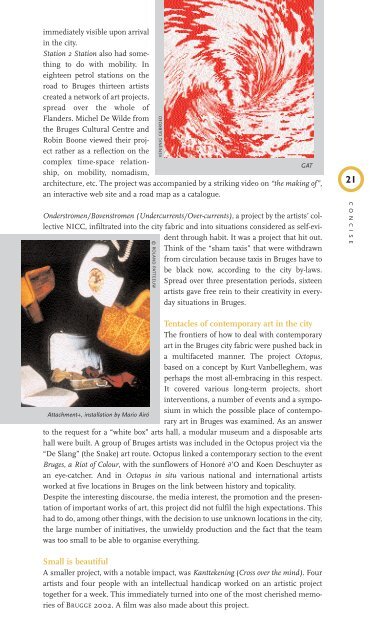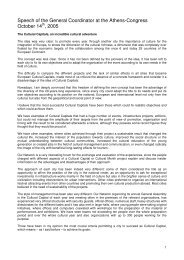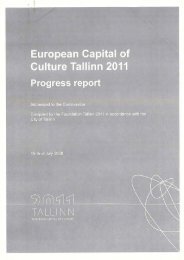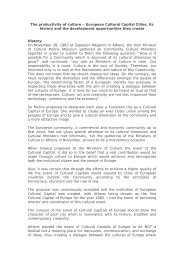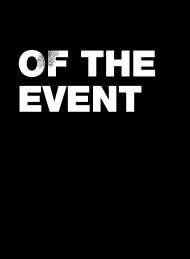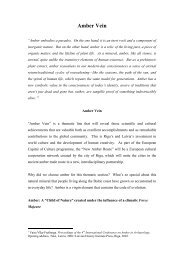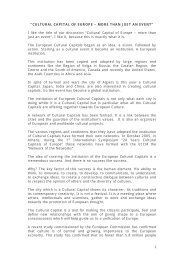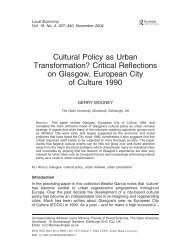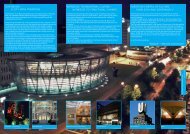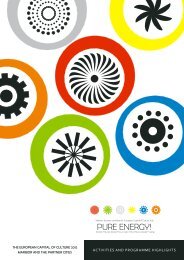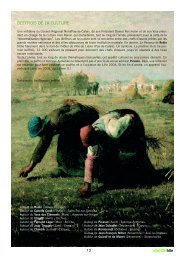Concise.pdf - Brugge Plus
Concise.pdf - Brugge Plus
Concise.pdf - Brugge Plus
- No tags were found...
You also want an ePaper? Increase the reach of your titles
YUMPU automatically turns print PDFs into web optimized ePapers that Google loves.
immediately visible upon arrival<br />
in the city.<br />
Station 2 Station also had something<br />
to do with mobility. In<br />
eighteen petrol stations on the<br />
road to Bruges thirteen artists<br />
created a network of art projects,<br />
spread over the whole of<br />
Flanders. Michel De Wilde from<br />
the Bruges Cultural Centre and<br />
Robin Boone viewed their project<br />
rather as a reflection on the<br />
complex time-space relationship,<br />
on mobility, nomadism,<br />
GAT<br />
architecture, etc. The project was accompanied by a striking video on “the making of”,<br />
an interactive web site and a road map as a catalogue.<br />
Onderstromen/Bovenstromen (Undercurrents/Over-currents), a project by the artists’ collective<br />
NICC, infiltrated into the city fabric and into situations considered as self-evident<br />
through habit. It was a project that hit out.<br />
Think of the “sham taxis” that were withdrawn<br />
from circulation because taxis in Bruges have to<br />
be black now, according to the city by-laws.<br />
Spread over three presentation periods, sixteen<br />
artists gave free rein to their creativity in everyday<br />
situations in Bruges.<br />
© ROLAND PATTEEUW<br />
VENIJNIG GEBROED<br />
21<br />
CONCISE<br />
Tentacles of contemporary art in the city<br />
The frontiers of how to deal with contemporary<br />
art in the Bruges city fabric were pushed back in<br />
a multifaceted manner. The project Octopus,<br />
based on a concept by Kurt Vanbelleghem, was<br />
perhaps the most all-embracing in this respect.<br />
It covered various long-term projects, short<br />
interventions, a number of events and a symposium<br />
in which the possible place of contemporary<br />
art in Bruges was examined. As an answer<br />
Attachment+, installation by Mario Airó<br />
to the request for a “white box” arts hall, a modular museum and a disposable arts<br />
hall were built. A group of Bruges artists was included in the Octopus project via the<br />
“De Slang” (the Snake) art route. Octopus linked a contemporary section to the event<br />
Bruges, a Riot of Colour, with the sunflowers of Honoré ∂’O and Koen Deschuyter as<br />
an eye-catcher. And in Octopus in situ various national and international artists<br />
worked at five locations in Bruges on the link between history and topicality.<br />
Despite the interesting discourse, the media interest, the promotion and the presentation<br />
of important works of art, this project did not fulfil the high expectations. This<br />
had to do, among other things, with the decision to use unknown locations in the city,<br />
the large number of initiatives, the unwieldy production and the fact that the team<br />
was too small to be able to organise everything.<br />
Small is beautiful<br />
A smaller project, with a notable impact, was Kanttekening (Cross over the mind). Four<br />
artists and four people with an intellectual handicap worked on an artistic project<br />
together for a week. This immediately turned into one of the most cherished memories<br />
of BRUGGE 2002. A film was also made about this project.


